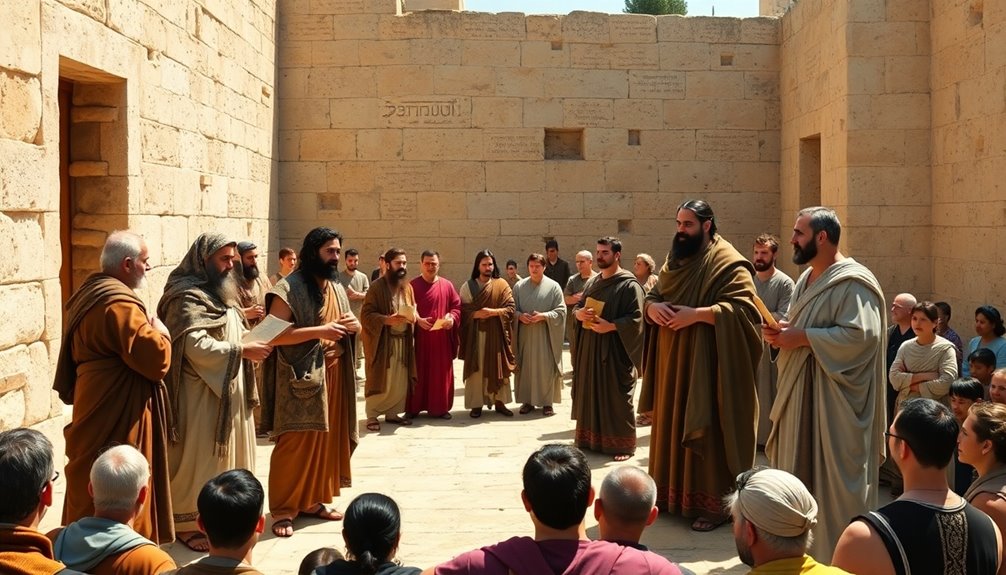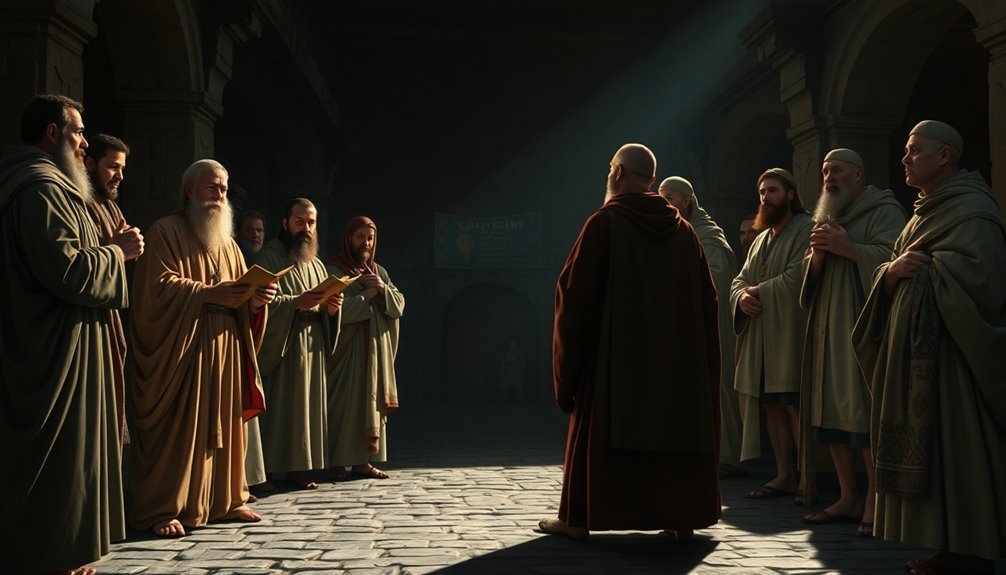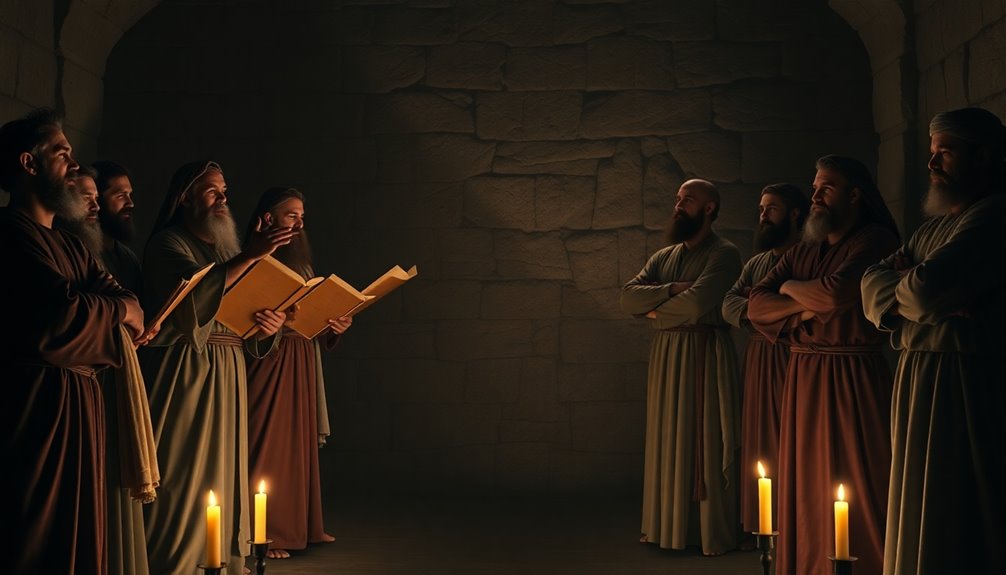The Pharisees and Sadducees were two influential groups in ancient Judaism, each with unique beliefs. The Pharisees, about 6,000 strong, focused on community practices, individual piety, and upheld Oral Law, believing it was essential for interpreting the Written Torah. In contrast, the Sadducees, comprised mainly of the Jewish aristocracy, rejected Oral Law, sticking strictly to the first five books of the Bible and prioritizing Temple rituals for political power. Their rivalry shaped Jewish life, especially after the Temple's destruction. If you explore deeper, you'll uncover more fascinating details about their beliefs and legacies.
Key Takeaways
- Pharisees emphasized Oral Law and community practices, while Sadducees focused on Temple rituals and aristocratic governance.
- Theological disputes arose from Pharisees' belief in resurrection and Oral Tradition, contrasting with Sadducees' strict adherence to the written Torah.
- Cultural influences during Roman occupation shaped Pharisaic personal spirituality and Sadducean political power dynamics.
- The destruction of the Second Temple in 70 CE led to the decline of Sadducees, while Pharisees adapted by codifying Oral Law into the Mishnah.
- Interactions with Jesus highlight Pharisees' legalism and Sadducees' political alignment, reflecting their differing approaches to scripture and authority.
Introduction

Throughout history, the Pharisees and Sadducees have stood out as two pivotal Jewish sects during the Second Temple period. You'll find that the differences between these groups were significant and shaped much of Jewish thought and practice.
The Pharisees, numbering around 6,000, represented the common people and focused on oral traditions, interpreting the Torah in ways that allowed for flexibility and adaptation. They believed in concepts like resurrection, an afterlife, and the existence of angels, which set them apart from the Sadducees.
On the other hand, the Sadducees, primarily composed of the Jewish aristocracy, adhered strictly to the written Torah. They rejected the Pharisaic beliefs in resurrection and an afterlife, favoring a more literal interpretation of the scriptures.
This divergence in belief systems led to conflicts between the two sects, especially as they interacted with figures like Jesus during His ministry. Their distinct roles also influenced the socio-political landscape of ancient Israel.
While the Pharisees ultimately shaped Rabbinic Judaism after the Temple's destruction in 70 CE, the Sadducees faded from the historical record, marking their significant yet contrasting impact on Jewish history.
Biblical Texts and References

When you explore the biblical texts, you'll notice that the Pharisees and Sadducees play crucial roles in the New Testament narratives.
Primary references, like Matthew 22:23-33 and Mark 12:18-27, showcase their interactions with Jesus, revealing their differing beliefs.
Additionally, secondary references highlight how these groups influenced early Christian thought and community dynamics.
Primary Bible References
Understanding the primary Bible references to the Pharisees and Sadducees illuminates their contrasting beliefs, particularly regarding the resurrection. The Pharisees believed in the resurrection of the dead, a belief Jesus affirmed in conversations like those in Matthew 22:23-33, where He directly engages with the Sadducees, who denied this fundamental doctrine.
Their disbelief is further illustrated in Mark 12:18-27, where they challenge Jesus on resurrection and marriage in the afterlife, showing their rejection of core beliefs held by the Pharisees.
In Acts 23:6-8, the Apostle Paul cleverly leverages this theological divide, declaring his Pharisaic background to incite discord among the council. The Gospels often depict Pharisees as legalistic and hypocritical, as seen in Matthew 23:1-36, while Sadducees are portrayed as aligned with political power, often opposing Jesus for maintaining their status.
Luke 20:27-40 reinforces the Sadducees' skepticism about resurrection, marking them as adversaries in the ongoing conflict with Jesus. By examining these references, you can grasp the deep-seated differences that shaped their theological and political landscapes.
Secondary Bible References
Examining secondary Bible references reveals further nuances in the beliefs and practices of the Pharisees and Sadducees. The Pharisees valued both the written Torah and oral tradition, as noted in Matthew 15:3, while the Sadducees strictly adhered to the written law. This distinction became crucial during the Apostle Paul's trial in Acts 23:6, where he leveraged his Pharisaic background to create division between the two groups.
The Sadducees notably denied the resurrection, as seen in their questioning of Jesus in Matthew 22:23-28 regarding a woman married to seven brothers. This skepticism towards resurrection contrasted sharply with the Pharisees, who embraced the concept of life after death.
Additionally, the Pharisees believed in angels and spirits, which the Sadducees outright rejected, further highlighting their theological differences (Acts 23:8).
Both groups were instrumental in the events leading to Jesus' crucifixion, with the Pharisees challenging Him on legal matters and the Sadducees focused on preserving their political power (John 11:48).
These secondary references deepen your understanding of how these two factions influenced early Jewish society and its response to Jesus.
Second Temple Judaism Dynamics

The dynamics of Second Temple Judaism were shaped significantly by the rivalry between the Pharisees and Sadducees, two prominent sects with contrasting beliefs and practices.
The Pharisees, numbering around 6,000, emphasized oral traditions alongside the written Law, passionately advocating for the belief in resurrection. They gained popularity among the common people through their teachings in synagogues, making their interpretations of the Law accessible and relatable.
On the other hand, the Sadducees, primarily the priestly elite, focused solely on the written Torah and denied any notion of an afterlife. Their control over the Temple and its rituals allowed them to maintain significant political power, often clashing with the Pharisees over religious authority and the direction of Jewish practices.
This rivalry didn't just define religious life; it also reflected broader societal tensions, especially as Hellenistic influences began to permeate Jewish culture.
As the Second Temple stood, the differences between these sects influenced how Judaism evolved, leading to distinct interpretations of the Law.
However, after the destruction of the Second Temple in 70 CE, the Pharisees' traditions laid the groundwork for what would become rabbinic Judaism, while the Sadducees faded into obscurity.
Cultural Influence on Beliefs

Cultural influences shaped the beliefs of the Pharisees and Sadducees in distinct ways, reflecting their unique positions within society.
The Pharisees, representing the common people, emphasized oral traditions that resonated with the masses. Their focus on community practices made their beliefs more relatable, especially as they advocated for individual piety and ethical living outside the temple. This approach aligned with the cultural shift towards personal spirituality, particularly significant during Roman occupation.
In contrast, the Sadducees, closely tied to the Temple and the priestly elite, were heavily influenced by Hellenistic culture. They rejected oral traditions, opting instead to adhere strictly to the written Torah. Their collaboration with Roman authorities and focus on temple rituals aimed at maintaining political stability reflected a cultural adaptation that ultimately isolated them from the broader Jewish populace.
The Pharisaic belief in resurrection and an afterlife emerged partly as a response to these cultural currents, embracing ideas of immortality and divine justice prevalent in Hellenistic thought.
Thus, the differing cultural influences significantly shaped the beliefs of the Pharisees and Sadducees, highlighting their contrasting roles in Jewish society.
Pharisees' Oral Traditions Debated

When exploring the Pharisees' oral traditions, you might come across common misconceptions about their role and authority.
Many people misinterpret the relationship between these traditions and the written Torah, leading to confusion about their significance in Jewish law.
Understanding these nuances is crucial to appreciating the ongoing debates between the Pharisees and Sadducees.
Debunk Common Misconceptions
Misunderstandings about the Pharisees often stem from a lack of awareness regarding their Oral Traditions. Many people mistakenly believe that the Pharisees disregarded the written Torah, but that's far from the truth.
In fact, they viewed the Oral Law as a crucial supplement, providing necessary interpretations and applications of the written laws given to Moses. This approach set them apart from the Sadducees, who strictly adhered to the written Torah and rejected the Oral Law.
The Pharisees believed the Oral Law was passed down through generations, essential for understanding and applying the written laws in everyday life. Their teachings were later codified in the Talmud, reflecting their distinct practices and beliefs.
The theological disputes between the Pharisees and Sadducees highlighted these differences, with the Sadducees arguing for a rigid interpretation of scripture.
Misinterpretation of Scripture Authority
Throughout history, debates over the interpretation of Scripture have revealed significant tensions between the Pharisees and Sadducees, particularly regarding the authority of oral traditions. The Pharisees upheld these traditions as essential complements to the written Torah, believing they were divinely given alongside God's law. In contrast, the Sadducees rejected oral traditions, advocating for a strict, literal interpretation of the first five books of the Bible.
This fundamental disagreement often led to disputes over scriptural authority. The Pharisees argued their oral traditions provided necessary interpretations, especially concerning Sabbath observance and purity laws.
However, Jesus frequently challenged this reliance, accusing the Pharisees of misinterpretation that overshadowed the true intent of God's law. In Mark 7:8-9, he criticized them for prioritizing human traditions over divine commandments.
These conflicts highlighted deeper theological divisions within Judaism and shaped the way early followers of Jesus approached the Law. As you explore the implications of these debates, consider how the differing views on scripture authority influenced not just Jewish practices but also the development of early Christian teachings.
The tension between the Pharisees and Sadducees continues to resonate in discussions about biblical interpretation today.
Faith in Daily Decision-Making

When you think about daily decisions, consider how your beliefs shape those choices.
The Pharisees integrated faith into their everyday lives through community engagement and ethical practices, while the Sadducees focused more on ritual.
This contrast highlights how different interpretations of faith can influence not just personal actions, but also the broader community.
Daily Choices Reflect Beliefs
Daily choices often reveal the core beliefs that guide our lives, shaping how we navigate ethical dilemmas and relationships.
For the Pharisees, daily choices were deeply influenced by their emphasis on oral tradition and ethical living. They believed in the resurrection, which motivated them to seek justice and compassion in their interactions, encouraging personal piety and support for the community. You can see this reflected in their everyday decisions, as they prioritized moral integrity over mere ritual.
In contrast, the Sadducees focused strictly on the written Torah and Temple rituals, making daily choices that often favored their aristocratic status. Their collaboration with Roman authorities led them to prioritize stability and wealth, reflecting a more secular approach to faith. Unlike the Pharisees, their decisions were influenced by a desire to maintain power rather than community engagement.
These differing beliefs about resurrection and oral law shaped how each group approached daily challenges. While the Pharisees engaged in social justice, the Sadducees concentrated on preserving their elite status, illustrating how daily choices are a window into deeper beliefs.
Your choices, too, reflect what you hold true in your heart.
Community Engagement Strategies
How can community engagement strategies shaped by faith influence your daily decision-making? When you consider the approaches of the Pharisees and Sadducees, it becomes clear.
The Pharisees actively engaged with their communities through synagogues, emphasizing personal piety and ethical living. They encouraged you to integrate faith into daily life, shaping your decisions through both written and oral traditions. This framework allows you to navigate personal and social matters while maintaining a strong Jewish identity.
On the other hand, the Sadducees focused on Temple rituals and governance, which limited their impact on everyday lives. Their strict adherence to the literal interpretation of the Torah made their community engagement rigid and less adaptable.
In contrast, the Pharisaic emphasis on community and individual prayer became crucial after the Temple's destruction, reinforcing Jewish practices and identity.
Pharisees Prioritized Oral Traditions

Prioritizing oral traditions, the Pharisees established a framework that significantly shaped Jewish religious life. Unlike the Sadducees, who dismissed these traditions, the Pharisees believed that the Oral Torah was crucial for interpreting the Written Torah. They argued that the Oral Law was given alongside the Written Law at Sinai, providing essential guidance for daily life.
As a result, the Pharisees developed a rich tapestry of oral traditions and interpretations. These teachings emphasized personal piety and ethical conduct, fostering a sense of community among followers. You'd see how their approach made Judaism more inclusive, allowing people to navigate the complexities of life while adhering to the Law.
A monumental achievement of the Pharisees was the codification of the Oral Law into the Mishnah around the 3rd century CE. This preserved their intricate teachings and ensured future generations could benefit from their insights.
Additional Resources

To deepen your understanding of the Pharisees and Sadducees, you can explore a variety of resources that delve into their beliefs, practices, and historical contexts.
Start with scholarly articles or books that highlight the distinctions between these two prominent sects during the Second Temple period. For instance, look into how the Pharisees emphasized oral traditions and beliefs in resurrection and an afterlife, contrasting sharply with the Sadducees, who adhered strictly to the written Torah and rejected those concepts.
You might also consider examining the New Testament, where you'll find references to these groups that reflect their theological debates and societal roles.
The Pharisees' influence on local synagogues and community teachings often sparked tensions with the Sadducees, who controlled the high priesthood and Temple practices.
Documentaries or lectures can provide visual context, helping you grasp how the destruction of the Second Temple in 70 CE led to the Sadducees' disappearance while the Pharisees laid the groundwork for Rabbinic Judaism.
Frequently Asked Questions
What Is the Difference Between Pharisees and Sadducees?
When you explore differing beliefs, you'll find that one group emphasizes personal piety and community practices, while the other focuses on ritualistic governance and strict adherence to written texts.
One values both oral traditions and texts, creating a comprehensive system of behavioral guidelines. In contrast, the other prioritizes only the written word, leading to a more rigid interpretation of their faith.
These distinctions shape their practices and influence among the people they engage with.
What Did the Sadducees Believe That the Pharisees Did Not?
The Sadducees believed in strict adherence to the written Torah and rejected the idea of resurrection and an afterlife. They saw life as finite, focusing on the here and now, which shaped their understanding of justice and morality.
Unlike others, they dismissed the existence of angels and demons, limiting their spiritual worldview. This belief system influenced their practices and interactions with the community, centering on Temple rituals rather than broader ethical teachings.
Who Is a Pharisee Today?
Today, when you think of a Pharisee, you're looking at the historical roots of Rabbinic Judaism.
You'll find that modern Jewish practices, influenced by Pharisaic teachings, emphasize study, prayer, and ethical living.
Many within the Orthodox community embrace this legacy, adhering to both the written and oral laws.
You might notice how the concept of the Oral Law continues to shape contemporary Jewish customs and theological discussions, reflecting a commitment to these traditions.
Was Paul a Pharisee or a Sadducee?
You'll find that Paul identified himself as a Pharisee, emphasizing his belief in the resurrection and the Oral Law. His education under Gamaliel highlights his deep roots in Pharisaic tradition.
Throughout his writings, he reflects these beliefs, particularly focusing on faith and justification. When faced with opposition, he strategically leveraged his Pharisaic identity, showcasing his commitment to these teachings even after his conversion to Christianity.










